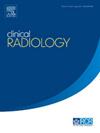头颈部非鼻咽淋巴上皮癌的影像学特征
IF 1.9
3区 医学
Q2 RADIOLOGY, NUCLEAR MEDICINE & MEDICAL IMAGING
引用次数: 0
摘要
头颈部淋巴上皮癌(LEC)在鼻咽部以外的地方是罕见的。描述其表现的放射学文献有限。我们的研究旨在总结影像学特征和临床特点。材料和方法这是一项回顾性队列研究,对来自当地两个主要医院群的经病理证实的LEC病例进行研究。研究了多模态预处理成像特征。统计数据和临床信息,包括治疗、无复发生存期(RFS)和总生存期(OS)。结果30例患者共检出30例lec,其中大唾液腺内19例,大唾液腺外11例。肿瘤表现为T2中间信号,扩散受限(平均表观扩散系数[ADC] 0.701x10−3 mm2/s),中度强化,18f -氟脱氧葡萄糖(FDG)高密度。边缘不清(90%)和侵犯邻近结构(43.3%)是常见的,特别是73.7%的主要唾液腺肿瘤表现为广泛的腺体侵犯。淋巴结转移很常见,占21/30(70%),38.1%表现为坏死。存在淋巴结转移时RFS较差(P = 0.038),而存在OS时RFS较差,平均随访时间为53.5个月。在接受或未接受手术治疗的LEC患者之间,以及大唾液腺和非大唾液腺LEC之间,RFS和OS均无显著差异。结论头颈部LEC表现为中等T2W信号、中度强化、扩散受限、FDG密集度高、淋巴结转移伴坏死倾向,与文献报道的鼻咽癌相似。存在淋巴结转移的无复发生存率较差,但手术或化疗治疗的无复发生存率相似。本文章由计算机程序翻译,如有差异,请以英文原文为准。
Imaging features of non-nasopharyngeal lymphoepithelial carcinoma of the head and neck
AIM
Lymphoepithelial carcinoma (LEC) of the head and neck is rare outside the nasopharynx. Radiological literature describing its appearances is limited. Our study aims to summarise the imaging features and clinical characteristics.
MATERIALS AND METHODS
This is a retrospective cohort study on pathologically proven cases of LEC from two local major hospital clusters. Multimodality pretreatment imaging features were studied. Demographics and clinical information, including treatment, recurrence-free survival (RFS) and overall survival (OS) were also evaluated.
RESULTS
Thirty LECs were identified in thirty patients, comprising 19 in the major salivary glands and 11 outside the major salivary glands. Tumours showed T2 intermediate signal, restricted diffusion (mean apparent diffusion coefficient [ADC] 0.701x10−3 mm2/s), moderate enhancement, and high 18F-fluorodeoxyglucose (FDG) avidity. Ill-defined margins (90%) and invasion of adjacent structures (43.3%) were common, notably 73.7% of major salivary gland tumours showed extensive glandular invasion. Nodal metastases were common, in 21/30 (70%), and 38.1% showed necrosis.
RFS was worse in the presence of nodal metastasis (P = 0.038) but not in OS, with a mean follow-up time of 53.5 months. There were no significant differences in RFS or OS between LEC patients treated with or without surgery, or between major salivary gland and nonmajor salivary gland LECs.
CONCLUSION
Head and neck LEC shows intermediate T2W signal, moderate enhancement, diffusion restriction, high FDG avidity and a propensity for nodal metastasis with necrosis, similar to those described in the literature for NPC. Recurrence-free-survival was worse in the presence of nodal metastases but was similar when treated by surgery or chemo-radiotherapy.
求助全文
通过发布文献求助,成功后即可免费获取论文全文。
去求助
来源期刊

Clinical radiology
医学-核医学
CiteScore
4.70
自引率
3.80%
发文量
528
审稿时长
76 days
期刊介绍:
Clinical Radiology is published by Elsevier on behalf of The Royal College of Radiologists. Clinical Radiology is an International Journal bringing you original research, editorials and review articles on all aspects of diagnostic imaging, including:
• Computed tomography
• Magnetic resonance imaging
• Ultrasonography
• Digital radiology
• Interventional radiology
• Radiography
• Nuclear medicine
Papers on radiological protection, quality assurance, audit in radiology and matters relating to radiological training and education are also included. In addition, each issue contains correspondence, book reviews and notices of forthcoming events.
 求助内容:
求助内容: 应助结果提醒方式:
应助结果提醒方式:


